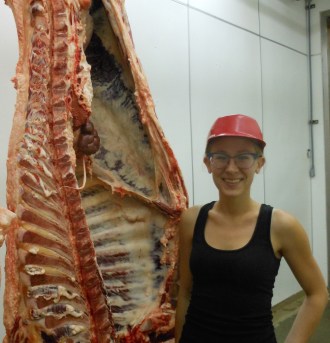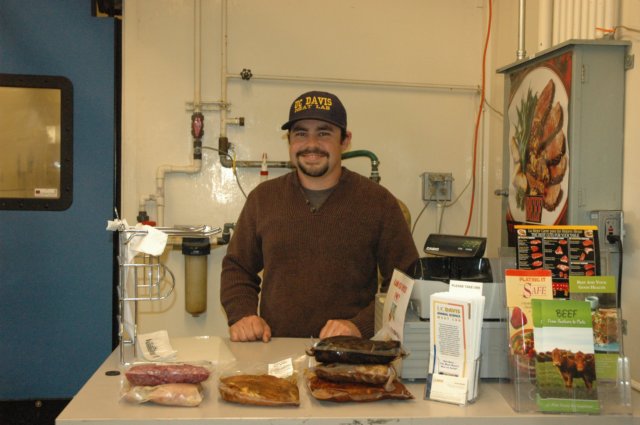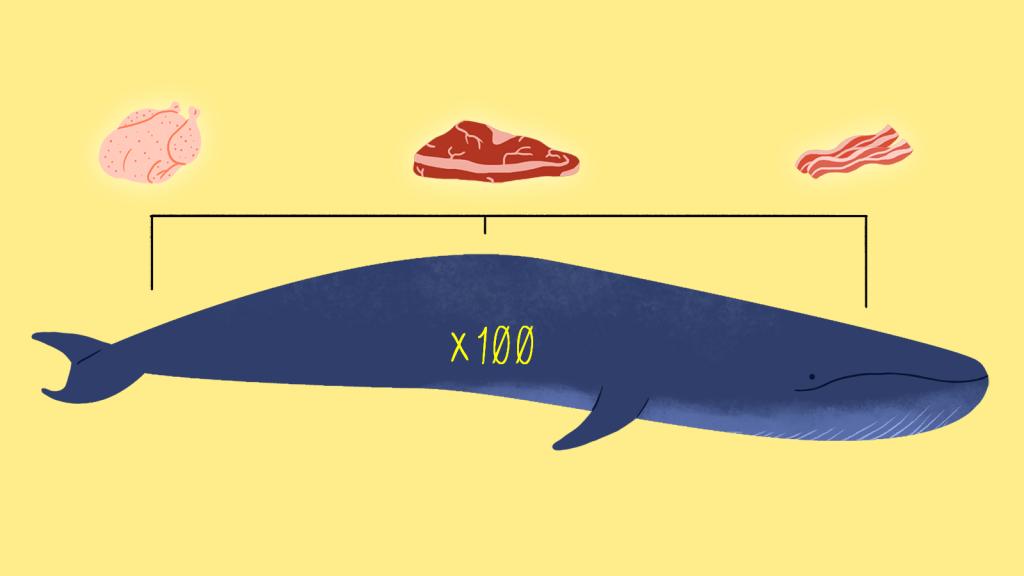I went to the slaughterhouse to see what happened to the animals, yes, but even more, to see what happened to myself. I wanted to test my expectations against reality, and I wondered how the experience would affect me.
When I told the UC Davis geneticist and cattle enthusiast Alison Van Eenennaam that I was planning on writing about meat, she said she could set up a visit to the university slaughterhouse for me to see steers being processed. Huh, I thought, that could be interesting. I felt as if I’d already watched a slaughter because I’ve seen so many videos and read so many accounts — journalistic descriptions, hot-to-the-touch activist screeds, fictional scenes, combinations of the three — that I had to search my memory to determine if I’d ever been present myself.
I’d cracked trout on the head, and put trapped mice out of their misery. But, no, upon reflection, I had never seen the killing of livestock.
The UC Davis slaughterhouse is across from the animal sciences building where Van Eenennaam works. It’s a small teaching facility, designed to handle just a few animals at a time. We walked over in the morning — it was still cool, with occasional breaths of midsummer heat. From the front it’s just a nondescript brown building.
[grist-related-series]
We strolled around behind the building, stopping to say hello to the horses and an old sway-backed donkey penned there. Van Eenennaam pointed out the chute where the animals would step out of the truck and into a narrow path between tubular steel fences. As we came around the corner of the building I noticed fresh dung in the path, and Van Eenennaam exclaimed, “Oh, they’re already here.” I looked up and met the big liquid eyes of a black steer, craning his neck to look back at us. Ahead of that steer was another — white with brown spots — also looking back at me.
I thought I understood the hard reality of agriculture and expected to be unfazed by this experience. But something about those steers fazed me. These animals have only a few minutes left to live, I thought. It was frightening to know that — to realize that I was standing right there at the intersection of life and death, and that my actions could affect that transition.
We went through a gate, up past the animals. At the end of the path was a panel that could be lifted straight up on a pulley. On the other side of that panel the path continued for the length of a cow, then ended, forming a rectangular box.
“This is the knock box,” Van Eenennaam said. Here, a steer will walk in, a worker will position a bolt gun precisely between the eyes, and a charge of gunpowder will knock a bolt against the steer’s head hard enough to render him insensible. The knock box has concrete walls with a little window in the front and a wide stainless steel panel on one side. When the steer falls, that stainless steel panel will rotate, allowing it to slide into the slaughterhouse.
A few feet away there was a door for the living. We entered a high-ceilinged room clad in stainless steel. There were no conveyor belts, as I’d seen in videos of commercial slaughterhouses. One steer was already dead, its skinless head resting on a countertop while four workers methodically broke down the carcass. An inspector in a white frock and USDA helmet stood watching. The man in charge curtly directed us to the locker rooms. I put on a white frock, a red helmet, and brown rubber boots.
Van Eenennaam introduced me to the fellow in charge, Caleb Sehnert, a burly man with a thick black mustache and goatee. He and the other workers wore black waterproof aprons and worked with silent intensity. It was clear that everyone knew precisely what needed to be done and stepped to the tasks without any need to talk. Sehnert was the one who did the knocking, and he motioned for me to follow him when he went outside for the next steer.
“Did you want to see this?” he asked.
I nodded.
“You can watch through the window, but go down there a ways back. I don’t want anything unusual that might spook him.”
I stood a dozen paces off, in the gravel, watching through the little window in the knock box. Sehnert hauled on the chain to lift the panel, and the white and brown steer ambled into the knock box. I could feel myself growing nervous, my heart speeding up, my breaths coming shorter and faster, and I was wildly projecting my anxiety onto the steer. Surely it must have some sense that something is wrong I thought; surely, the way it lifted its head to look up at Sehnert, then lowered it to sniff the ground and peer at me through the window, indicated growing dread. But of course I’d seen cattle make the same movements when entering a stall and scoping it out for food.
Sehnert gently urged the second steer — which was also pushing into the knock box — far enough back to lower the panel. He crouched behind the wall, stealthy, then stood and positioned the bolt gun just so.
Bang. I walked inside quickly and there was the steer, kicking and thrashing. The animal was out, it was clear — a round wound was positioned precisely between its eyes — but misfiring signals were sending spasms through its muscles. My lungs still felt as if they’d been tied in half, but my pulse was already slowing. The critical moment had passed.
The workers looped a chain around the steer’s hind hooves and hoisted it up until it hung, head down. Sehnert made a deft, vertical cut at the throat and deep red blood cascaded out. Before, the steer had just been knocked out; now it was dead. The workers moved unhurriedly, but made quick work of the carcass. Within a few minutes they had lowered it down to its back on a sort of rolling steel cradle, washed it, removed the head, and cut away the hide. The exposed muscle twitched.
“There’s a lot of muscle movements,” Van Eenennaam said. “That’s something that might bother someone who doesn’t understand what’s going on. But it’s parasympathetic. Obviously it’s not conscious — I mean, the head is off.”
The inspector — he would not give his name, saying the USDA frowns on individual inspectors identifying themselves — shook his head at the growing ignorance of food production. “Kids don’t ever see what happens. I’ve run into people who tell me bacon comes from a cow.”
“Do you think seeing something like this is an experience all school children should have?” I asked.
“Not very very young children — if they are too young it might be traumatic. But high school students, yes.”
With a short burst of energy from an electric “brisket saw,” the workers split the steer’s breastbone. With delicate, stroking knife movements, they separated more of the hide from the body.
“If you watch, they are so careful about not spreading contamination,” the inspector told me. “See how they are always washing down, and dipping their knives?” There were several hot water baths around the room for sterilizing knives.
The workers hoisted the carcass up again, spilling the inner organs out into a container.
“It’s kind of scary how easily it all comes out,” Van Eenennaam said, wryly. She pulled on a pair or blue latex gloves and pulled out the lungs — she has a professional interest in lungs, because she has studied bovine pneumonia. “They have remarkably small lungs for such a big animal. They really weren’t made for running, like a horse. So any loss of lung capacity really affects them.”
Meanwhile, Sehnert was preparing to split the first carcass in two. He picked up what looked like a six-foot-long chainsaw — something Arnold Schwarzenegger might wield in an action movie.
“This is the hardest job in the plant,” Van Eenennaam said. “He’s got to cut right down the middle of the backbone without cutting the spinal cord.”
Sehnert rose up into the air on a rising platform, bearing his mother-of-all-chainsaws. He put it in place and it whined through the bone. The platform, controlled by a foot lever, descended as he cut until he reached the bottom and the two sides of beef swung apart.
Once the second steer was out of the way, Sehnert went back outside to knock the last one. I stayed inside and watched through the gap beneath the stainless steel panel, and could see its hooves as it plodded into the box, a glimpse of its nose as it sniffed the ground, a strand of saliva trailing from its mouth.
Once again, I began to tense up in anticipation. It reminded me a little of the way I felt when my first child was born. That too, had been a critical transition — the beginning, rather than the end of life. In both situations I’d been scared that something would go terribly wrong, and wanted intensely to do my part to prevent suffering — which gave me a stiff, self-conscious awkwardness as I tried to stay out of the way.
Again: bang. I jumped, and the steer’s hooves also left the ground. Then the panel rotated and the black and white Angus-Hereford-cross rolled into the room. Once more, the disassembly progressed with smooth professionalism. I tried to make sense of what I was feeling, but “I certainly don’t feel totally OK right now” was all that ended up in my notebook.
I had been feeling sorry for the workers — students or recent grads, all of them. It just seemed like a physically and emotionally taxing job. But when I spoke to them, they were incredibly enthusiastic. One of the workers, Lauren Eis, wore funky blue cat-eye glasses and a tank top under her smock. Her arms were bare and blood was drying on her chest. “It’s a really great job,” she told me. “It’s really fulfilling.”
“Really?” I asked. “What makes it fulfilling?”
“There just aren’t many places like this,” she said. “You get to see the whole process, not just your little part. I mean, an animal walks in here, and you get to move it all the way through until it’s food for people. It’s really fulfilling to provide food for people. Most people we get working here stay until they have to leave.”

Lauren Eis with a side of beef.
The other two workers were similarly upbeat — even the guy washing stinky, fermenting grass out of a rumen. Then I approached Sehnert and asked him if he thought the anxiety I’d felt in watching those steers die would disappear if I saw it enough.
“Even I still get a little nervous,” he said. “It’s my least favorite part of the job. I don’t enjoy killing things. But cattle are creatures of utility, you have to remind yourself — this is why they were born and raised.”
Some nervousness is only natural, he said, “And it’s good to have that little bit of nerves — to keep you sharp. You don’t want to get relaxed about it.”
I explained that I was there, in part, to try to close the gap between people and their food, and asked what myths or misperceptions he bumped up against.
“When people find out what I do they often say, ‘Oh that’s nice, you’ve got this small facility, you must treat those animals so much better.’ But I really don’t think that large-scale plants get away with anything more than we do.”

Caleb Sehnert at the sales counter.Courtesy of the UC Davis Meat Lab
They may be bigger, with more workers and more animals, but being big doesn’t make a slaughterhouse any less humane, he said. The reason Sehnert likes working in the small, college facility is that he gets to help educate people. “That’s my favorite part,” he said. “Talking to people like you. When students come through here to learn about digestive anatomy, it’s just a privilege to be able to show them the real thing. That’s something they are going to think about every day.”
Since all the animals for the day had been killed, Van Eenennaam and I shook hands with Sehnert and the inspector and took our leave. We walked out through the front, where there’s a small shop. Every Thursday people from around Davis come to buy meat and eggs and the various foods that the students make with the meat as part of their training.
I got a bag of pepperoni with parmesan and sundried tomatoes. It was spicy and delicious. I was still a little shaken from watching those steers die, but that didn’t translate into any reluctance to eat meat.
I left with a renewed sense that any death, including the death of an animal, was a perilous event that must be handled with great care. Most of all, I felt a new sense of respect for the people who did this difficult work so well. The way Sehnert’s team had moved, quickly, but without hurry, in sync, but without speaking — it was impressive. Anyone who eats meat, I think, would do well to give a moment to think with grateful respect of the animal that died, and the people who skillfully handle that fraught transition between life and death.



